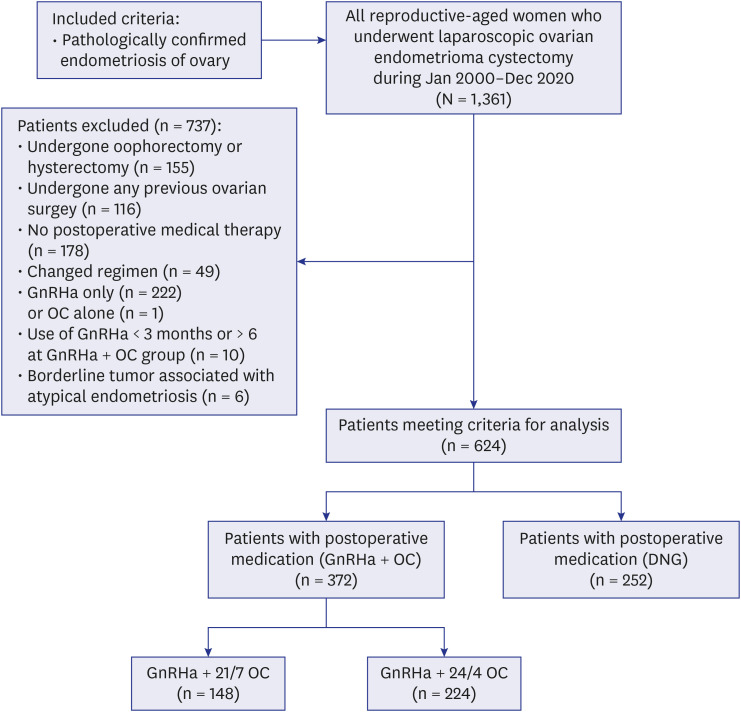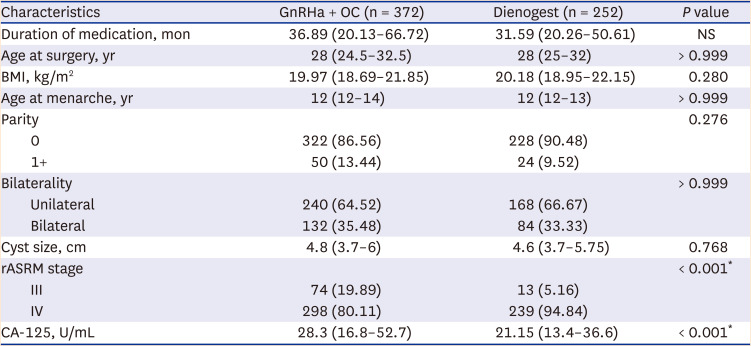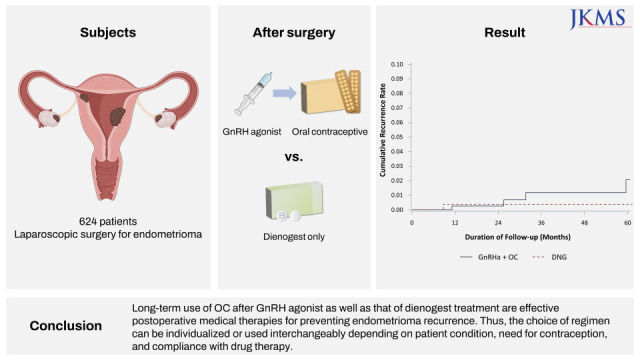1. Giudice LC. Clinical practice. Endometriosis. N Engl J Med. 2010; 362(25):2389–2398. PMID:
20573927.
2. Donnez J, Binda MM, Donnez O, Dolmans MM. Oxidative stress in the pelvic cavity and its role in the pathogenesis of endometriosis. Fertil Steril. 2016; 106(5):1011–1017. PMID:
27521769.

3. Jenkins S, Olive DL, Haney AF. Endometriosis: pathogenetic implications of the anatomic distribution. Obstet Gynecol. 1986; 67(3):335–338. PMID:
3945444.
4. Chapron C, Marcellin L, Borghese B, Santulli P. Rethinking mechanisms, diagnosis and management of endometriosis. Nat Rev Endocrinol. 2019; 15(11):666–682. PMID:
31488888.

5. Johnson NP, Hummelshoj L. World Endometriosis Society Montpellier Consortium. Consensus on current management of endometriosis. Hum Reprod. 2013; 28(6):1552–1568. PMID:
23528916.
6. Leyland N, Casper R, Laberge P, Singh SS. SOGC. Endometriosis: diagnosis and management. J Obstet Gynaecol Can. 2010; 32(7):Suppl 2. S1–32.

7. Dunselman GA, Vermeulen N, Becker C, Calhaz-Jorge C, D’Hooghe T, De Bie B, et al. ESHRE guideline: management of women with endometriosis. Hum Reprod. 2014; 29(3):400–412. PMID:
24435778.

8. Zanelotti A, Decherney AH. Surgery and endometriosis. Clin Obstet Gynecol. 2017; 60(3):477–484. PMID:
28742580.

9. Guo SW. Recurrence of endometriosis and its control. Hum Reprod Update. 2009; 15(4):441–461. PMID:
19279046.

10. Fedele L, Bianchi S, Zanconato G, Berlanda N, Raffaelli R, Fontana E. Laparoscopic excision of recurrent endometriomas: long-term outcome and comparison with primary surgery. Fertil Steril. 2006; 85(3):694–699. PMID:
16500340.

11. Vercellini P, Buggio L, Berlanda N, Barbara G, Somigliana E, Bosari S. Estrogen-progestins and progestins for the management of endometriosis. Fertil Steril. 2016; 106(7):1552–1571.e2. PMID:
27817837.

12. Lee SR, Yi KW, Song JY, Seo SK, Lee DY, Cho S, et al. Efficacy and safety of long-term use of dienogest in women with ovarian endometrioma. Reprod Sci. 2018; 25(3):341–346. PMID:
29161960.

13. Vercellini P, Somigliana E, Daguati R, Vigano P, Meroni F, Crosignani PG. Postoperative oral contraceptive exposure and risk of endometrioma recurrence. Am J Obstet Gynecol. 2008; 198(5):504.e1–504.e5. PMID:
18241819.

14. Zheng Q, Mao H, Xu Y, Zhao J, Wei X, Liu P. Can postoperative GnRH agonist treatment prevent endometriosis recurrence? A meta-analysis. Arch Gynecol Obstet. 2016; 294(1):201–207. PMID:
27052442.

15. Lee DY, Bae DS, Yoon BK, Choi D. Post-operative cyclic oral contraceptive use after gonadotrophin-releasing hormone agonist treatment effectively prevents endometrioma recurrence. Hum Reprod. 2010; 25(12):3050–3054. PMID:
20937741.

16. Seo JW, Lee DY, Kim SE, Yoon BK, Choi D. Comparison of long-term use of combined oral contraceptive after gonadotropin-releasing hormone agonist plus add-back therapy versus dienogest to prevent recurrence of ovarian endometrioma after surgery. Eur J Obstet Gynecol Reprod Biol. 2019; 236:53–57. PMID:
30884336.

17. Muzii L, Maneschi F, Marana R, Porpora MG, Zupi E, Bellati F, et al. Oral estroprogestins after laparoscopic surgery to excise endometriomas: continuous or cyclic administration? Results of a multicenter randomized study. J Minim Invasive Gynecol. 2011; 18(2):173–178. PMID:
21262590.

18. Practice Committee of the American Society for Reproductive Medicine. Treatment of pelvic pain associated with endometriosis: a committee opinion. Fertil Steril. 2014; 101(4):927–935. PMID:
24630080.
19. Ouchi N, Akira S, Mine K, Ichikawa M, Takeshita T. Recurrence of ovarian endometrioma after laparoscopic excision: risk factors and prevention. J Obstet Gynaecol Res. 2014; 40(1):230–236. PMID:
24102958.

20. Adachi K, Takahashi K, Nakamura K, Otake A, Sasamoto N, Miyoshi Y, et al. Postoperative administration of dienogest for suppressing recurrence of disease and relieving pain in subjects with ovarian endometriomas. Gynecol Endocrinol. 2016; 32(8):646–649. PMID:
26890948.

21. Busacca M, Somigliana E, Bianchi S, De Marinis S, Calia C, Candiani M, et al. Post-operative GnRH analogue treatment after conservative surgery for symptomatic endometriosis stage III-IV: a randomized controlled trial. Hum Reprod. 2001; 16(11):2399–2402. PMID:
11679528.

22. Uemura T, Mohri J, Osada H, Suzuki N, Katagiri N, Minaguchi H. Effect of gonadotropin-releasing hormone agonist on the bone mineral density of patients with endometriosis. Fertil Steril. 1994; 62(2):246–250. PMID:
8034067.

23. Vercellini P, Somigliana E, Vigano P, Abbiati A, Barbara G, Fedele L. ‘Blood On The Tracks’ from corpora lutea to endometriomas. BJOG. 2009; 116(3):366–371. PMID:
19187368.

24. Spona J, Elstein M, Feichtinger W, Sullivan H, Lüdicke F, Müller U, et al. Shorter pill-free interval in combined oral contraceptives decreases follicular development. Contraception. 1996; 54(2):71–77. PMID:
8842582.

25. Vlahos N, Vlachos A, Triantafyllidou O, Vitoratos N, Creatsas G. Continuous versus cyclic use of oral contraceptives after surgery for symptomatic endometriosis: a prospective cohort study. Fertil Steril. 2013; 100(5):1337–1342. PMID:
23953327.

26. Seracchioli R, Mabrouk M, Frascà C, Manuzzi L, Montanari G, Keramyda A, et al. Long-term cyclic and continuous oral contraceptive therapy and endometrioma recurrence: a randomized controlled trial. Fertil Steril. 2010; 93(1):52–56. PMID:
18973896.








 PDF
PDF Citation
Citation Print
Print






 XML Download
XML Download